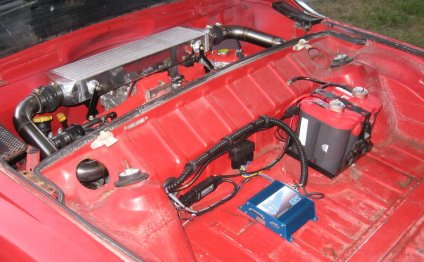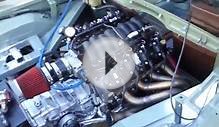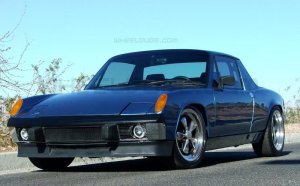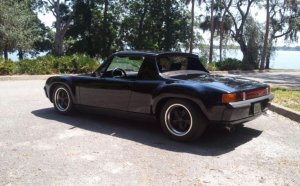| [Click on Photo]
Figure 1: 914-6 Oil Container
Figure 2:
914-6 Five Part Sheet Metal Kit
Figure 3:
914-6 temperature Exchanger (left part)
Figure 4:
Initial 914-6 2.0L Six-cylinder Motor
Figure 5:
Cut-away view of 914-6 with system Installed
Figure 6:
After-market 2-Piece Sport Mount
(Vellios)
Figure 7:
Sport-mount shown set up
Figure 8:
911 Muffler Under inventory 914-4 back valance
Figure 9:
After-market Aluminum Oil Tank
(Vellios)
|
Review
There's small doubt that ultimate project for a 914 could be the 914-6 transformation. Whenever Porsche initially built the 914-6, they did actually touch upon a very great idea. However to numerous, the follow-through felt lacking. After around three years of manufacturing, the 914-6 ended up being discontinued. The original 914-6 had a somewhat changed version of the 911T motor, which numerous thought was a little anemic. Garnering just 110 Horsepower, this six-cylinder engine is only 10 HP greater than the European 914 2.0L engine introduced in many years later, with comparable torque production (see contrast chart). There's some debate, nonetheless as to how Porsche rates it is motors. The 914-4 engine, created by VW is probably rated at the average horsepower score, whereas Porsche HP ratings tend to be listed at the minimum HP. Thus a 100 HP VW motor and a 100 HP Porsche motor aren't probably be comparable in general horsepower.
The aim of this guide is always to familiarizes you with the task and give you somewhat information on what exactly is needed to do the transformation. We shy far from offering info on updating your tires to your five-lug pattern alongside suspension system customizations, as you can do your whole motor transformation separately of everything else.
Lots of people frequently ask about the differences between the very early 914-4s and the 914-6. Here's a listing of them, and there is probably some lacking, therefore drop united states a line when you can consider whatever else that may be included with the list.
- 914-4 cars utilized a by-product of VW 411 engine, the 914-6 utilized a variation of this 911T motor. The 911T motor has generally been thought of as horse-power restricted, yet rather dependable. 914-6 motors were generally speaking serialized starting with the numbers 640. The 914-6 vehicles were constantly identified by their particular VIN quantity, which started utilizing the figures 914. The four-cylinder automobiles' VIN figures didn't start out with 914.
- The 914-6 utilized a triple-throat Weber Carburetor system, whereas the 914-4 utilized Bosch MPC gas injection. Yet another gasoline pump ended up being used to give you the carbs, including an alternate relay board to run the gas pump.
- The 914-6 ended up being originally designed with disc brake system and larger calipers compared to 914-4. The leading brake and suspension system ended up being typically much like the 911T, but the rear calipers and rotors were special into the 914-6. 914-6 rear braking system calipers can be hard to come by, and look exactly the same as the 914-4 calipers through the outside. However, obtained a larger brake piston inside. The 914-6 also included a 19mm master cylinder, whereas the 914-4 had the 17mm one. Torsion bars are from the 911T.
- The 914-6 motor uses a dry-sump which needs a separate oil container. This oil tank is shown in Figure 1. This oil tank is attached to the remaining region of the engine area in-between the fender plus the interior panel of the motor storage space. Four split oil lines must connect the oil container into engine.
- The engine for the 914-6 needs various sheet material to suit in the engine storage space. Five split pieces comprise the 914-6 sheet steel system. This sheet metal is shown in Figure 2. There's absolutely no synthetic engine rainfall tray on the 914-6 due to interference aided by the carburetors. Furthermore, the engine lid springs are 'softer' because engine lid tray is missing, making the entire cover somewhat lighter.
- The 914-6 transported with an alternate type of the 901 transmission. Although uncommon, this transmission is normally perhaps not desirable, since it was an early tail-shifter design which usually had difficulty moving in almost any situation. An extremely couple of wide range of 914-6s transported because of the Sportomatic transmission. Good-luck finding one, however.
- The 914-6 delivered with a five-lug design upon it's tires. Many cars had been equipped with the recommended Fuchs alloys utilized on the 911, but some 914-6s transported with five-lug steel wheels. There is additionally a five-lug version of the Mahle tires readily available.
- The 914-6 used a motor mount that was welded in to the vehicle, connected to the backside for the firewall. The 914-4 engine connects to two motor supports that hang down on each region of the car.
- The 914-6 had an unusual steering line and ignition switch. The ignition switch had been situated on the dashboard, instead of the steering wheel. The 914-6 also had an electric powered windshield washer as opposed to the spare-tire pressure-fed system applied to the 914-4. The 914-6 also utilized yet another steering wheel which may not be interchanged with a 914-4 wheel because of the differing spline patterns.
- The devices when you look at the dashboard had been different when you look at the 914-6. The tachometer read as much as 8000, the speedometer read to 150, plus the heat gauge was combined with the gas measure. The 914-6 additionally had a hand throttle the motor, situated inside front of shifter.
- The 914-6 had a 914-6 emblem regarding the back, and a five-lug structure spare. Furthermore, it's reported that there ended up being a particular 914-6 jack.
- The 914-6 temperature exchangers tend to be different through the 914-4, as is the muffler, and also the rear valance panel. The stock left side heat exchanger is shown in Figure 3.
System
It's possible to write constantly about which motor is most beneficial to use in a 914-6 conversion. There are many kinds, and you ought to most likely pick the motor based on what overall performance you may like to get, plus what machines can be found. 2.0L 911T engines are most likely the most frequent, as well as the most affordable, nonetheless they never pack too much of a punch. These engines are practically the same as the original 914-6 2.0L motor, shown in Figure 4. 2.7 911 motors tend to be effective, but they aren't very reliable. The 3.0L SC engine appears to be a & most trustworthy, but it needs a modified flywheel to fit the 901 transmission. 2.2L and 2.4L engines have a good mix of reliability and horsepower, and tend to be the way to go. The 911 motors (2.2L & 2.4L) into the S-type fundamentally have all of the power curves aimed at the top end, plus don't really fit of the same quality street engines. The 911E engines (2.2L & 2.4L) have actually good low-end torque and great drive-ability. The 911T engines have less horse power as compared to E and S motors, and and a really uniform torque range plus high dependability. This, definitely, is a matter of viewpoint, and undoubtedly will be different depending upon who you talk to.
The best advice on acquiring the motor will be receive the most useful condition engine possible. Remember that 911 motor rebuilds are costly (brand-new pistons and cylinders alone are priced at around $3K), so condition counts for loads. Before you grab a motor, it might be great to own some documents on it to ensure that it was correctly preserved.
An excellent update for the engine should install the Carrera pressure-fed string tensioners. It is often stated that it's perhaps not whether your string tensioners will fail, but once. With the engine out from the vehicle, this improvement is definitely worth every penny. If tensioners fail, the valves could potentially hit the the top of pistons, causing catastrophic problems for the engine. The complete kit expenses about $425, and it is worthwhile insurance coverage against destroying your motor.
Once you have your engine, you are going to need to get an engine mount. The 914-6 engine is shown attached into the automobile in Figure 5. There are usually two types of mounts. The first and easiest supports on existing 914 engine supports. This is called a quick-six mount, and seems like the 914 engine mount bar. The principal drawback to the mount is you need certainly to change the shift-linkage club.
The next variety of mount may also be known as the sport-mount. Modeled after the initial mount, it is welded and bolted on the rear of this firewall when you look at the motor area. This mount is shown in Figure 6 and installed in car in Figure 7. There clearly was an additional the main mount which can be connected to the motor. The principal disadvantage for this mount is the fact that it takes a tiny bit of welding. Fortunately your welding can be carried out following the engine is set up when you look at the vehicle. In this case, the mount is bolted into firewall - a joint which strong adequate to withstand the original drive to the welding store. To weld the mount using motor set up, you will need to get rid of the proportioning valve, and press the gas lines out of the way. Following the welding is done, you will need to change the proportioning valve, and rebleed the brake system.
It is necessary not to forget that you'll likewise require an accelerator linkage. A number of different varieties occur, based upon just who means they are. There are lots of brackets which bolt about the transmission. The stock 914-6 accelerator linkage bracket needs that two holes be drilled and tapped into the intermediate full bowl of the transmission. You may most likely need an accelerator cable, bracket, and linkage pole that expands up to the motor area.
The 914-6 motor could be identified by its serial quantity. An authentic 914-6 motor will have a serial quantity within the range 64270 (my resources let me know that's the range; the very last number can be slightly off). The serial quantity is found in an unusual area compared to the 911 serial number. The serial number is located on top of motor nearby the oil breather housing, and may be noticeable from the the surface of the engine area. The serial number on 911 engines is found nearby the lover housing (on 911s, this would be the trunk of the engine).
Exhaust
There are two choices for exhaust on a 914-6 conversion. It is possible to go with the standard 914-6 headers (what we do), you can also try to find some 914-6 heat exchangers. The headers work very well into the automobile. Their just disadvantage is you drop temperature when you look at the car. I did not believe that this could be a problem within my car, however it rapidly is now one with the absence of a great defrost system. Utilized 914-6 heat exchangers can be purchased for around $1000 moobs - a pricey figure but almost needed if you'd like temperature. An alternate is always to grow your own group of heat exchangers that surround the headers. This will be recorded in a technical article later on.
The 914-6 uses a muffler just like the 911. The 914-6 muffler wont fit under the standard 914-4 back valance panel. Its tailpipe exits the muffler at about a ninety level position into muffler. However, the stock 911 muffler meets good under the rear valance panel beneath the bumper as its angled a lot more like the 914-4 muffler. The 911 muffler is visible beneath the stock 914-4 valance panel in Figure 8. 911 mufflers can be plentiful in addition they look much like the 2.0L 'hotdog' mufflers under the 914. The 914 2.0L muffler bracket is an immediate replacement the 914-6 muffler bracket necessary to hang the 911 muffler.
Fuel System
The gasoline pump needs to be coordinated for the style of gas shot utilized on the six-cylinder motor. Once you acquire the motor and injection, make an attempt to obtain the 911 gas pump that originally came with the injection system. Fuel pumps differ quite a bit, tend to be hard to differentiate, and value about $250 brand-new. Reconstructed gasoline pumps in many cases are unreliable, and therefore are not generally suitable for use in conversions. To get the gas pump to get results properly, you need to jumper some cables in the electric relay board inside engine area. Simply because the now-absent Electronic Fuel Injection computer originally controlled the fuel pump.
A set of triple-barrel carbs or the technical gas shot will fit well to the motor area, even though the motor spill tray needs to be removed for approval. Whenever setting up a CIS system, there are a few items that you will need to transfer regarding engine to get it to squeeze in the automobile. An alternative solution will be cut some holes when you look at the trunk; a thing that I wanted in order to prevent no matter what. Additionally, you will have to take away the engine top latch, and change it with some race pin latches. The trunk springs will have to be removed as well. However, they may be able quickly be changed with gas-assisted bumps.
Clutch
The conventional 914 clutch will work with all the 914-6 conversion. The only piece of equipment that you need to have is an early 911, or 914-6 flywheel. This six-bolt flywheel was created to put on the six-cylinder crank also mate up with the 901 transmission. The first flywheels had been once difficult to get, nevertheless now they appear to be in more than sufficient offer. It is recommended which you update to a early 911 clutch with six springs into the disk as opposed to four. This will be a worthy improvement also for a four cylinder, and is really recommended for the installation of the six.
Transmission
Many people improperly advocate the upgrading for the transmission towards the subsequent 915 type utilized on the 911s. The simple fact associated with matter is the fact that 901 transmission can easily deal with as much as 200 HP, and is very nearly a significantly better shifting unit compared to the bulkier 915. You may add considerable weight towards vehicle, and make moving lots stiffer if you upgrade to a 915. Besides, the price of the parts result in the conversion extremely expensive. You ought to get a 915 transmission (usually over $1000), and then you need certainly to convert it with a so-called 916 kit, that may cost to $1500. The safe wager would be to keep the stock 901 tranny, and update later on if you believe it really is necessary.
The shift linkage might need to be modified if you use the quick-six installing bar for installing the six-cylinder motor. The reason being the bar is normally perhaps not built to accommodate the sift pole driving through it such as the original 914-4 shift bar.
Oil Cooling System
The 914-6 uses the dried out sump system of lubricating the motor, as does the 911. Consequently, the motor needs the installation of an oil tank in the engine area. This oil tank sits between he internal and outer fender associated with the 914 regarding the left side of the vehicle. There are basically two types of oil tanks readily available. Factory original oil tanks fit really and are also the initial oil container used within the 914-6. But they can be very high priced, and tough to find sometimes. Initial tanks are constructed with steel, copper plated and coated black colored. Discover an after-market oil container that's made from cast aluminum and won't rust. This container is shown in Figure 9. However, the fit of the tank is certainly not definitely ideal (some very minor alterations are needed), however its cost is a hundred or so dollars below the cost of the initial. This after-market tank has actually AN fittings which require making use of after-market oil lines too. The differences between your two tanks are reported within Q&A part, beneath the heading 914-6 Oil Tank variations.
The 914-6 makes use of four different oil lines.Two include the return range from the sump of motor towards oil container. The other two outlines make up the oil supply which works from the oil container into the motor. Those two lines are joined together underneath the automobile regarding the left side. The offer line is out there as two lines so your range might be disconnected and oil drained through the tank during oil changes. The 914-6 oil tank and engine sump typically simply take over 9 quarts of oil.
Besides the tank while the outlines, you ought to ensure that you have the right filler neck and oil filter mount the tank (not generally speaking added to the tank). A early 911 oil filler will suffice typically. Be sure that you have a dipstick and a cap because of the oil filler. Additionally need the rubber sleeve that attaches the filler throat into tank. Good alternative for the plastic sleeve are located in the trunk shelves of Residence Depot. Beware, these small oil tank items aren't always cheap or easy to locate.
The installation of the oil container needs that drill seven holes inside part of motor storage space. Happily, all 914s have actually indentations in their sheet steel where in actuality the holes are to be drilled. In the event that you look quietly of this wall surface inside your 914, they're situated simply above and below your relay box. You most likely never ever noticed them before - I know we never ever did. The holes that must definitely be drilled require a set of hole saws:
- 4" to 4.5" for oil filter
- 2" for breather hoses
- 2.5" for the filler neck
- 1.5" when it comes to 2 opening return line holes.
|
On early cars, there is certainly an opening currently drilled into the engine rack of 914 (covered with a synthetic connect generally). Drilling the holes is a somewhat simple procedure, and that can be performed with a regular hand drill.
Wheels and Tires
The first 914-6 usually was included with 14" Fuchs Alloy tires. These, i really believe, were an option from the car. The standard set of wheels that included the 914-6 had been five-lug steel alloys. Also offered had been 15" Fuchs alloys. Often labeled as the deep-offset rims, they're looked out by transformation proprietors since they fit much nicer in back fenders. Also available were the Mahle petrol Burner rims. These are also really desired because they're the lightest Porsche alloy available.
Miscellaneous |















